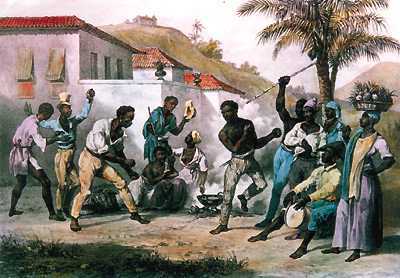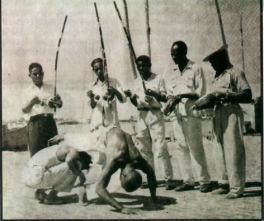
Capoeira: Artful Resistance
The history of slavery in the U.S. is taught nationwide; however, slavery elsewhere in the world is barely touched upon in school curriculum. Yet, the resilience and ingenuity that enslaved Africans displayed during and after the Trans-Atlantic slave trade extends beyond U.S. borders. From the 16th to 19th centuries, Brazil was the main destination for Africans sold across the Atlantic and contained the largest slave population in the world. Just as slaves in the U.S. used music, poetry and dance to preserve their heritage and subtly organize against oppressors, African slaves in Brazil also created new forms of art and defense. One of the most influential creations to come from this period is a type of martial arts called Capoeira.
Capoeira began in the mountains of Brazil in the 1500’s among groups of runaway slaves called Quilombos. The largest and most famous Quilombo, called the Quilombo dos Palmares, consisted of Africans from all over the continent, who banned together to defend their newfound freedom. Capoeira was initially created as a system of defense, a blend of the warfare styles of many types of African tribes. Incorporating fast and tricky movements with stealth agility and strength, Capoeira struck fear into colonists venturing into the Amazon jungle in an attempt to reclaim their property. When members of the Quilmbo dos Palmares were recaptured and placed on plantations they introduced Capoeira to other enslaved persons, eventually creating units of highly trained fighters. Music and singing often accompanied training sessions, leading plantation owners to view Capoeira as simply dancing.
After the abolition of slavery in the 19th century, Capoeira was deemed illegal, as newly freed Africans and their cultural traditions were viewed with suspicion and fear. Underground schools and communities continued to teach the art form, and its popularity grew throughout the country. In the late 1930s, public pressure forced the Brazilian government to legalize Capoeira.
Presently, Capoeira is taught and performed all over the world. Two major schools for Capoeira are located in New York Arte Capoeira Center and New York Capoeira Center. Both offer classes ranging from beginner through advanced study. DanceBrazil, a modern dance company founded by native Brazilian Jelon Vieira, is heavily influenced by Capoeira, and Vieira has presented his mixture of classical and AfroBrazilian dance to audiences worldwide. By taking a class or watching a performance of this mesmerizing practice you can experience the lasting influence of African descendants on the development of Brazilian culture.
by Michelle Grazio
>via: http://progressivepupil.wordpress.com/2013/09/17/capoeira-artful-resistance/


